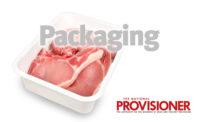If there’s one trend that food producers can’t ignore, it’s sustainability. Across all sectors, consumers are looking for ways to minimize their impact on the environment through the products they buy. In fact, Nielsen surveys say 73% of consumers are willing change to their buying habits to be more sustainable.
Many consumers see packaging as an easy answer when it comes to sustainability. According to Sean Riley writing for Provisioner Online:
Environmentally conscious consumers rule the day, and packaging is often the first element considered when making an eco-friendly purchase. Grocery shoppers are savvy enough to know which packages use fewer resources and energy than other packaging formats.
What does this mean for the meat industry? It means that consumers are feeling increasingly concerned about buying meat in a polystyrene foam tray covered with plastic film. But at the same time, the industry needs the functionality of those materials to maintain freshness. A balance is needed between sustainability and performance, and innovations in the packaging industry are helping reach it.
Changing Materials
The packaging industry is undergoing a lot of changes to answer consumers’ call for sustainability. New materials are coming onto the market that have functionality and performance required for packaging and selling fresh meat.
Some packaging is incorporating more recycled content to achieve consumers’ sustainability goals. Others, like bio-plastics or molded fiber from quickly renewing resources, offer packaging that is biodegradable or compostable.
The challenge is that these materials still have to function as producers and consumers expect them to function. They have to contain moisture, not allow the meat to stick to the package, and keep the product fresh for as long as possible, even through freeze and thaw cycles. As the sustainable packaging industry advances, we are seeing more affordable and sustainable materials that achieve desired standard performance metrics.
Fixing the Supply Chain
Another way to bring packaging in line with consumers’ sustainability expectations is to use locally produced packaging whenever possible. Many types of packaging today, including polystyrene foam and plastic are made from petroleum products, but shipping them long distances or even from overseas makes their carbon footprint even larger. There can also be issues in the post-consumer recycled content supply chain, making it an increasingly unreliable material for sustainable packaging.
Sourcing materials locally lowers the overall carbon footprint required to bring them to market, bringing packaging in line with the Eat Local and Shop Local movements. Since the source materials, like molded fiber, for domestic packaging are often produced by local farmers and landowners, consumers will feel even better about choosing products packaged in these materials.
Building the Future
To keep consumers engaged with your products, it’s vital to provide products to them in a way that enhances their purchase experience. As more consumers demand sustainability, what they perceive as wasteful packaging could turn them away from your products. Sustainable packaging is one solution that can retain or even grow your customer base for the future. IP




Report Abusive Comment